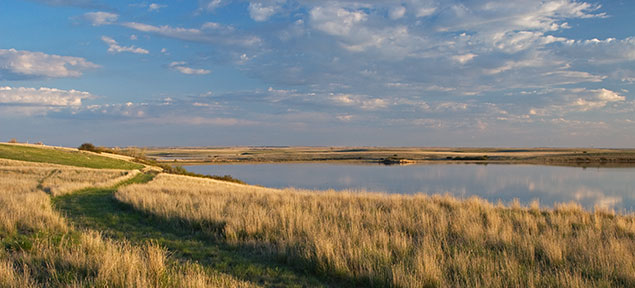
Brush Lake – A Treasure State Gem by Doug Smith
by Doug Smith
What follows is a guest column by our friend Doug Smith from Dagmar, Montana. Doug is the Sheridan County Planner and is well versed in the geology, anthropology and archeology, amongst other subjects, of northeast Montana. Brush Lake is located east of Plentywood, Montana.
Aside from its distinctive aquamarine blue color, Brush Lake looks like many other lakes that dot this prairie pothole region, however beneath its surface the lake is full of superlatives. The lake’s depth, chemistry, biology and hydrology all stand alone in making this a unique body of water.
For millions of years, before the last ice age, the Missouri River’s valley turned north just east of Poplar and the river flowed northeast to Hudsons Bay, joining the Yellowstone River valley just north of the international boundary in Saskatchewan.
In the last glacial epoch the continental ice sheets spread south grinding up the Canadian Shield and carrying it south to cover the northern portion of Montana and filling in the old river valleys. First the river valleys were filled with lake bottom clays from the dammed up rivers, then glacial till when the glaciers arrived, and finally with outwash sand and gravels when the ice retreated. Even as the ice front retreated north it continued to send tongues of ice down the old valley depression, and it left a great block of ice a mile long, a half mile wide and hundreds of feet thick where Brush Lake now sets. The melting ice front continued to wash down great volumes of sand and gravel to bury the ice block in place. Eventually a spruce forest grew over the slowly melting ice block, until it melted completely, sending a tangle of trees to the bottom of a 100 foot deep lake.
The buried outwash gravels and the deeper river terrace gravels are very porous and support a controlled groundwater irrigation area, as well as supplying Brush Lake with a continuous flow of water through large springs in the lake. Being in a closed basin, summer evaporation serves as a pump to keep groundwater flowing into the lake. And since evaporation only takes pure water out, the minerals leached from the glacial gravels remain dissolved in the lake and accumulate, giving the lake its distinct color. Certain algae and bacteria thrive in this flow of mineral rich water and they take what they need to grow and deposit the calcium and magnesium carbonates (limestone) in the form of cones, florets, and reefs on lake bottom. Brush Lake’s symbiotic twin is White Lake to the south. It is 4 to 6 feet lower and essentially an evaporation pan for the excess water seeping out of Brush Lake. White Lake is where all the sodium sulfate (alkali) comes out of solution and is deposited. The mineral laden water inflow, offsite evaporation and biotic action keeps Brush Lake’s water clear and fresh year round. It is one of the few lakes in the world where this dynamic process is found.
Much like tree rings the lake annually deposits a layer of light and dark sediment which can be used to construct a time line.
Being a deep lake (65 feet) in a closed basin, Brush Lake contains a sediment record of value to the scientific study of climate change. Since it first saw daylight 10,000 years ago, Brush Lake has accumulated 45 feet of sediments. Much like tree rings the lake annually deposits a layer of light and dark sediment which can be used to construct a time line. These layers contain pollen and distinct minerals which allow scientists to determine variations in climate since the ice age. Currently sediment cores are being studied by a collaborative team of scientists who are funded by a National Science Foundation grant. In a few years we should have a better understanding of how climate change has shaped this area of the northern Great Plains.
Over the years attempts have been made to stock the lake with fish, but with no success. It is theorized that all the oxygen in the groundwater is tied up in dissolving the calcium rich gravels resulting in poorly oxygenated lake water. In addition, Brush Lake’s water may be more similar to sea water than fresh water, making it tough for traditional sport fish to survive. That is not all bad, since Brush Lake is being developed as a water recreation area there will be no conflicts between motorboats and fishermen, and no need to worry about stepping on a fish-hook when jumping in for a swim. The Department of Fish Wildlife and Parks has let the contract for construction of improvements for this State Park and expects that construction will be completed by July, just in time for the summer recreation season when the lake warms up just enough to make it refreshing on a hot summer day.




